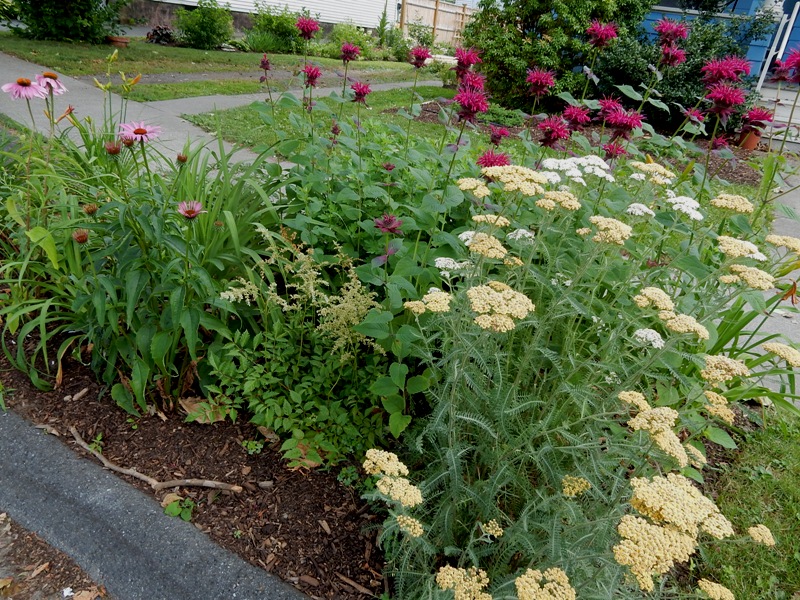
“Chances are, you have never thought of your garden — indeed, of all of the space on your property — as a wildlife preserve that represents the last chance we have for sustaining plants and animals that were once common throughout the U.S.” Douglas Tallamy.
Most of us welcome birds and butterflies to our gardens, but don’t spend much time thinking about bugs, except for pesky mosquitoes and Japanese beetles. Yet, even bugs, and there are hundreds of species of bug in our local landscape, are essential to our local ecosystem.
When we lived on 60 acres in Heath I didn’t worry about having a healthy ecosystem. After all, we had those 60 acres that included wild fields and woodlands to feed the birds and butterflies. My intent in any planting was just to bring some of the best pollinator plants close to the house so that I could enjoy watching pollinators at work.
Our move to Greenfield meant we had an opportunity to create our own wildlife preserve on our small lot. We also had to consider how to handle a large wet area. I was thrilled with the idea of making a garden that would welcome and support the butterflies and bees – and the bugs. My husband was happy that this kind of garden eliminated most of the lawn.
The new lot was mostly grass, but this was not fine turf and I was happy to see the lawn was filled with clover and violets which provide lots of early pollen for bees. It was a happy day for me when I realized what some consider lawn weeds are really important nectar plants.
Some of the pollinator plants that I brought with me from Heath include: spring blooming foam flower and irises; summer blooming coneflower, Russian sage, bee balm and yarrow; and fall blooming asters.

Then I turned once again to my favorite expert on sustaining wildlife, Douglas Tallamy, Chair of the Department of Entomology and Wildlife Ecology at the University of Delaware. He is the author of the brilliant and inspiring book Bringing Nature Home: How Native Plants Sustain Wildlife in Our Gardens. He also has a website, www.bringingnaturehome.net with lots of information and lists of plants that will help you bring nature to your home garden.
Everyone loves butterflies, but I never thought of them as pollinators. They are not like honeybees who have the equipment to pack pollen into ‘baskets’ on their knees, but even with their smooth and spindly butterfly legs they do pollinate plants. Butterflies will welcome nectar plants but they really count on host plants, those plants where they can lay their eggs, confident that the hatching caterpillars will be able to eat that plant.
Host plants for butterfly caterpillars can be quite specific. We all know that monarch butterfly caterpillars need milkweed. Other plants for other butterflies include spice bush or Lindera benzoin, clover, snapdragons, sunflowers, sweet fennel, parsley, dill, carrots, as well as sycamore, river birch, chokecherry, oak, poplar, locust and willow trees. Of course, there are many other host plants for the many species of butterfly.
In our new garden we planted river birch, chokecherry and spicebush as butterfly host plants. We also planted orange milkweed, Asclepius tuberosa, a smaller showier milkweed than the kind found in the wild. Since host plants are so specific for butterflies there is no way I can support many species, but I am doing what I can.
We are not purists, but we have concentrated on using native plants. Native plants and native bugs evolved at the same time over centuries. Native bugs know exactly the kind of greenery they need to thrive. And the native plants know they can spare some foliage to support the bugs without harming themselves. I do not get upset when I find insect damage on my viburnams. I know they can spare a few leaves.
That does not mean I don’t go around with my soapy water to collect and drown the Japanese beetles that are starting to appear. Japanese beetles are non-native bugs, but they seem to enjoy roses and raspberries and my yellow twig dogwood. Nature is not neat.
Strictly speaking, spiders are not bugs. But they eat bugs. I may not be very aware of their presence because many spiders are tiny, but big or small, all spiders are welcome in my garden.
We have planted the eye catching native buttonbush with its bottlebrush-type flowers, and summersweet, Clethra alnifolia, with its fragrant white panicles of summer bloom. Both welcome bees and butterflies to sip their nectar, and neither minds wet sites. With those large shrubs I achieve two goals.
We have planted other excellent perennial pollinator plants that like or tolerate wet sites. Sanguisorba canadensis, American burnet, has tall 4-5 foot flowering spikes of flowers beginning in midsummer, as does culver’s root or Veronicastrum virginicum. Possibly more common is Joe Pye Weed, with its pink-ish flower heads.
We have not completed our planting plan, but are well on our way to supporting butterflies, bees and other bugs. We are well on our way to creating a garden that is lovely and a joy. We are also learning many lessons along the way, another joy.
Between the Rows July 18, 2016
Yes, and it is fun watching you create this garden.
I’m impressed that you got that picture of a bee. Very nice. I spent a few minutes in the heat here picking Japanese beetles off the rose bushes. I try to have a pollinator garden with salvia and Joe-Pye weed included. Never knew my river birch was a possible host.
Tallamy’s work totally changed the way I think about insects in my garden. As was true for you in Heath, I have lots of native woodlands that provide important host plants. I’m impressed by how intentionally and successfully you’re creating a pollinator habitat in your new garden.